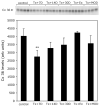Chapter 11--novel mechanism for hyperreflexia and spasticity
- PMID: 21333809
- PMCID: PMC3646581
- DOI: 10.1016/B978-0-444-53825-3.00016-4
Chapter 11--novel mechanism for hyperreflexia and spasticity
Abstract
We established that hyperreflexia is delayed after spinal transection in the adult rat and that passive exercise could normalize low frequency-dependent depression of the H-reflex. We were also able to show that such passive exercise will normalize hyperreflexia in patients with spinal cord injury (SCI). Recent results demonstrate that spinal transection results in changes in the neuronal gap junction protein connexin 36 below the level of the lesion. Moreover, a drug known to increase electrical coupling was found to normalize hyperreflexia in the absence of passive exercise, suggesting that changes in electrical coupling may be involved in hyperreflexia. We also present results showing that a measure of spasticity, the stretch reflex, is rendered abnormal by transection and normalized by the same drug. These data suggest that electrical coupling may be dysregulated in SCI, leading to some of the symptoms observed. A novel therapy for hyperreflexia and spasticity may require modulation of electrical coupling.
Copyright © 2011 Elsevier B.V. All rights reserved.
Figures




References
-
- Angel RW, Hofmann WW. The H Reflex in Normal, Spastic, and Rigid Subjects. Arch Neurol. 1963;9:591–596. - PubMed
-
- Arfaj A, Yates C, Reese NB, Ishida K, Skinner RD, Garcia-Rill E. Changes in the H-reflex after spinal cord injury: A longitudinal study in awake rats. Neurosci Abstr. 2007;33:405.22.
-
- Atsuta Y, Abraham P, Iwahara T, Garcia-Rill E, Skinner RD. Control of locomotion in vitro: II. Chemical stimulation. Somatosens Mot Res. 1991;8:55–63. - PubMed
-
- Atsuta Y, Garcia-Rill E, Skinner RD. Electrically induced locomotion in the in vitro brainstem-spinal cord preparation. Brain Res. 1988;470:309–312. - PubMed
-
- Ballon JS, Feifel D. A systematic review of modafinil: Potential clinical uses and mechanisms of action. J Clin Psychiatry. 2006;67:554–566. - PubMed
Publication types
MeSH terms
Grants and funding
LinkOut - more resources
Full Text Sources
Miscellaneous

